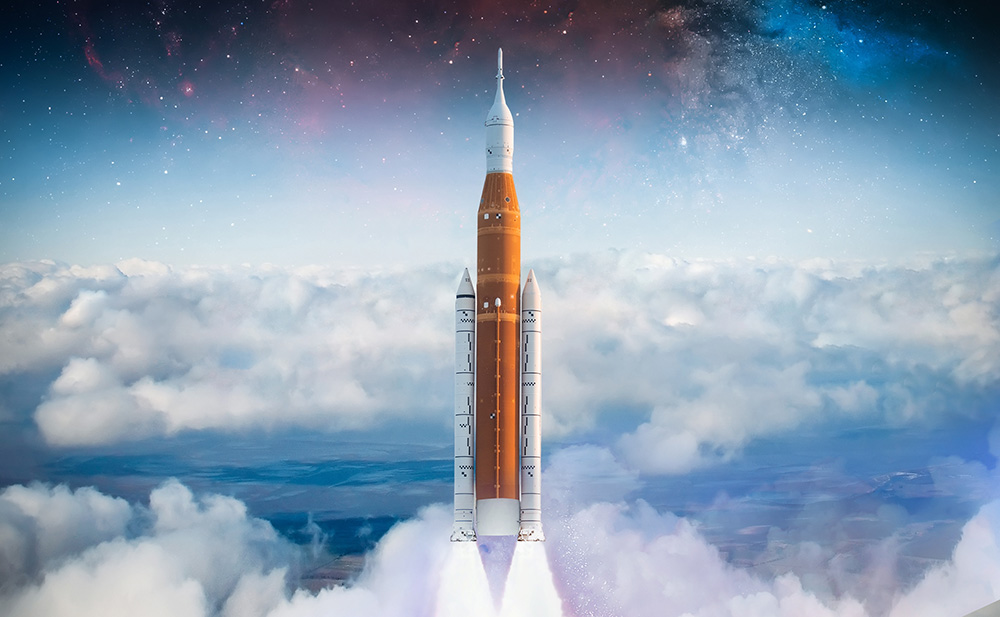
The Space Economy is rapidly emerging as a vital sector of economic opportunity, fostering innovation, creating jobs, and generating revenues across diverse industries.
Far from being merely about launching rockets or exploring planets, today’s Space Economy encompasses a wide range of activities, from satellite services and space tourism to manufacturing and R&D. Its recent growth is inspiring local governments, private companies, and educational institutions across the globe to explore their roles within this burgeoning sector.
The following article explores two facets of the Space Economy.
- The Legacy Space Economy, which refers to the traditional structure of the space sector, dominated by government-driven initiatives and a few major companies.
- The Modern Space Economy, which builds on the Legacy Space Economy but also encompasses the diverse, private sector-led space ecosystem.
The Legacy Space Economy
Over the past 50 years, the Space Economy has transformed from a government-driven domain to a dynamic, increasingly privatized, and highly competitive sector with diverse participants.
The 1990s marked the beginning of this shift, as governments started to see increasing potential in involving more private companies in space exploration and satellite deployment. New policies encouraged private investment, with companies such as Lockheed Martin Corporation (1995) and Northrop Grumman Corporation (1994) opening their doors and joining industry giants like Raytheon Technologies and the Boeing Company during this decade.
Plans for the International Space Station (ISS) were also announced in the early 1990s. Originally a partnership between the US and Russia, the ISS became a collaborative effort among multiple nations and laid the foundation for international partnerships in space.
Measuring the Legacy Space Economy
Most private investments and companies that grew out of the 1990s remained focused on supporting advancements in space exploration and relied heavily on government contracts.
Advancing space exploration capabilities and providing other government services continues to be a driving force even in today’s Space Economy.
Using the industries identified in the table above, the gross regional product (GRP) generated by the Legacy Space Economy increased by 43% between 2018 and 2023, growing from approximately $14.1 billion to more than $20.2 billion.
As of 2023, California was the largest contributor, accounting for nearly $6 billion or 29% of the nation’s total GRP. In addition to California, six other US states generated more than $1 billion in Legacy Space Economy GRP.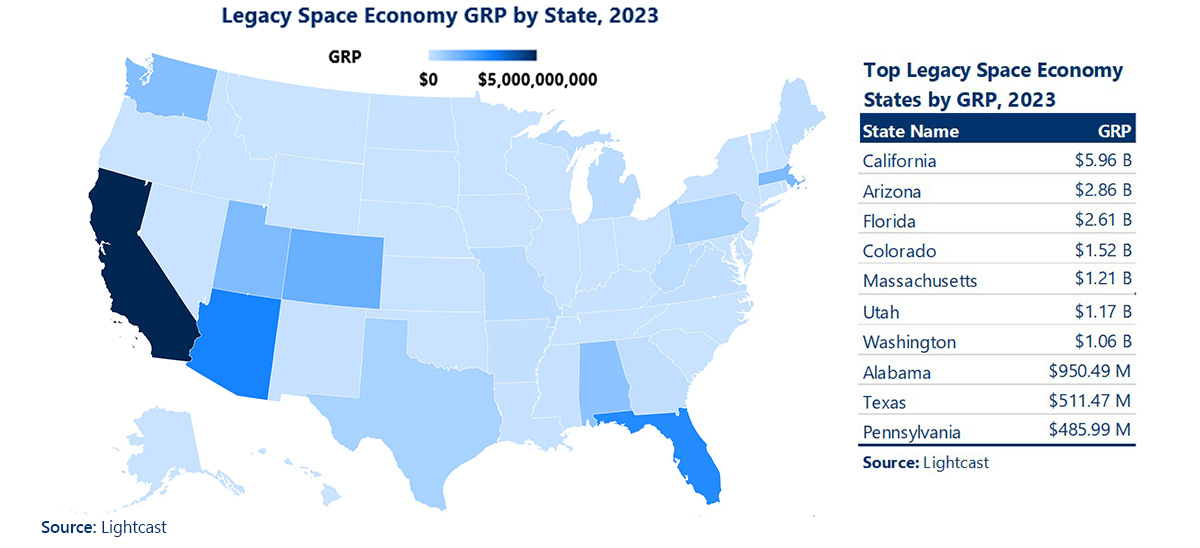
The Legacy Space Economy is still highly concentrated among a few key companies. According to IBIS World, four companies generated around 84% of the cluster’s total revenues in 2024.
Industries within the Legacy Space Economy continue to have high barriers to entry due in part to large startup costs, strict regulatory requirements, and complex/rapidly changing technological requirements.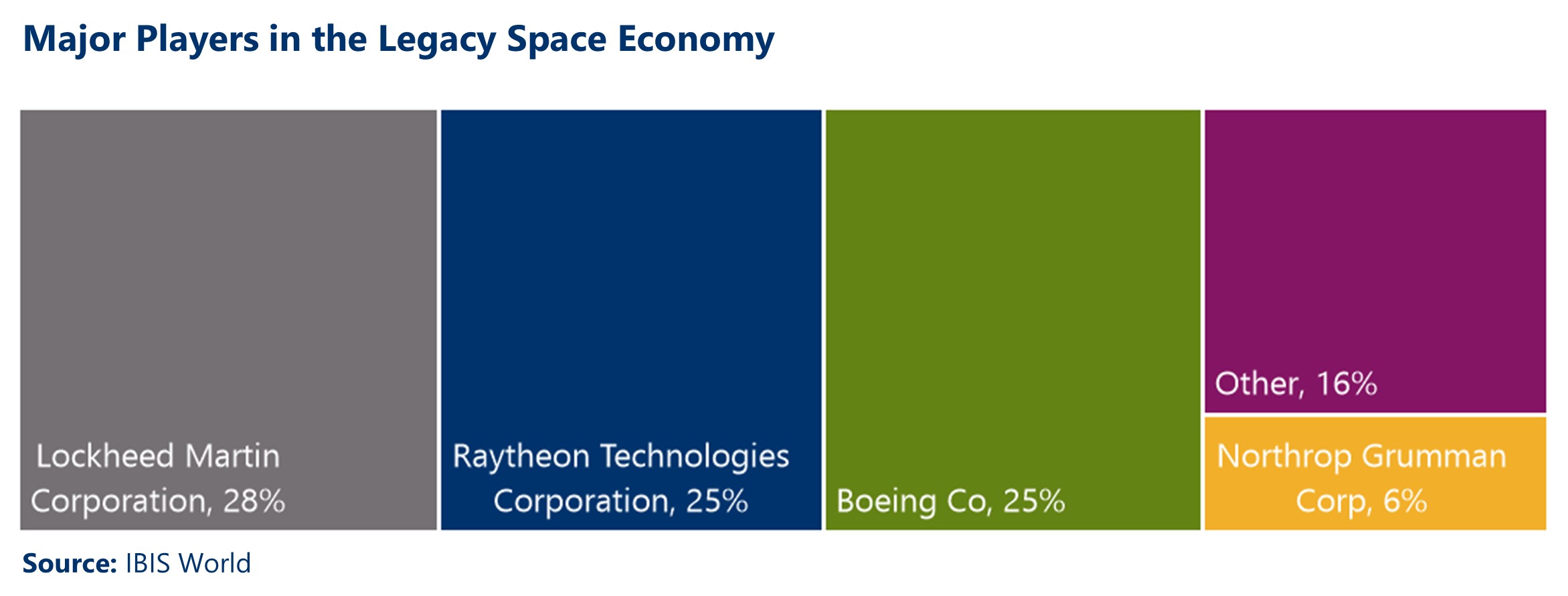
The Modern Space Economy
The Shift
According to the Space Foundation, a nonprofit organization that offers education, collaboration, and information for the global space ecosystem, the global Space Economy totaled $570 billion in 2023, a 7.4% increase from 2022, and nearly double the size of the Space Economy a decade ago. About 78% or $445.2 billion of this activity was generated by commercial operations.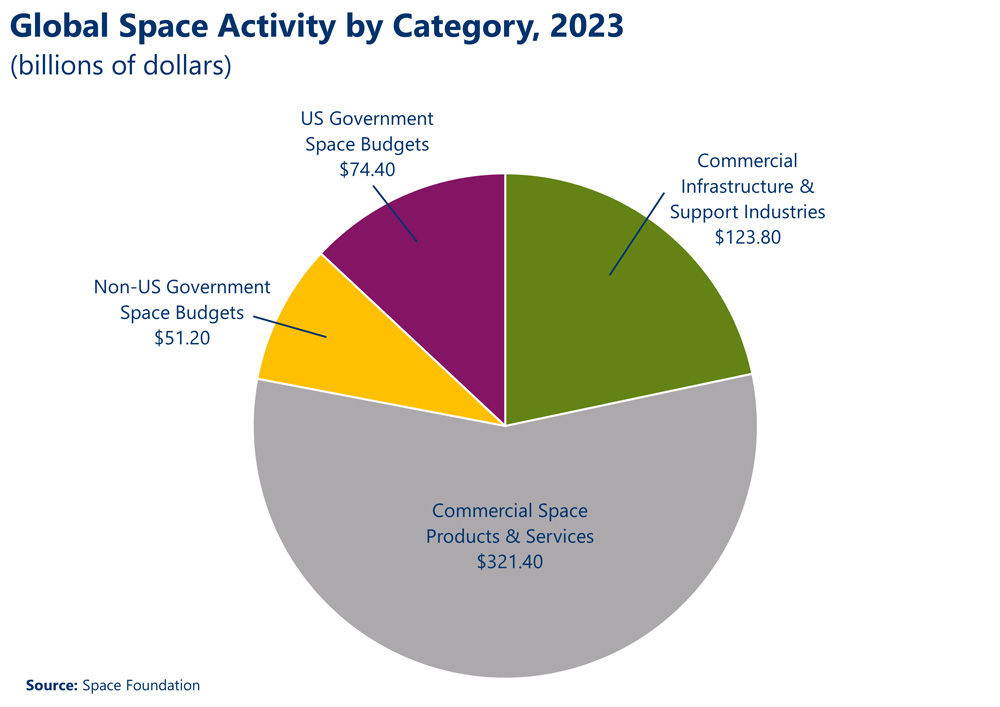
These global activity figures show the evolution of the Space Economy from the legacy, government-driven model to the Modern Space Economy, which is powered by private sector innovation and investment.
The Modern Space Economy emerged in the 2000s and was fueled by private companies like SpaceX, Blue Origin, Virgin Galactic, Rocket Lab, etc. Advancements by these companies in reusable rocket technology dramatically lowered launch costs, opening new commercial pathways and making space ventures more financially viable for companies and individuals.
While the Modern Space Economy encompasses the Legacy Space Economy, it spans dozens of other industries, challenging a neat NAICS (industry classification) definition. The Modern Space Economy includes:
- Satellite Services
- Launch Services
- Space Tourism
- Space Mining
- Space Manufacturing
- Space Infrastructure & Debris Management
Trends in the Modern Space Economy
Satellites and Launching Services
Private companies’ use of satellites has increased dramatically over the last few years. In a recent conversation between Camoin Associates’ Senior Vice President Dan Gundersen and Kelli Kedis Ogborn of the Space Foundation, Ogborn explained the growth in the commercial satellite industry. “Roughly, there are about 12,000 active satellites in orbit,” she said. “There’s already 20,000-plus licenses for launch, and by the year 2030, they think there’s going to be at least 58,000 satellites.”
Ogborn said that companies continue to employ satellites innovatively across industries, driving advancements in connectivity, data collection, and monitoring.
Satellite constellations like SpaceX’s Starlink and OneWeb extend high-speed internet access to remote areas, addressing connectivity gaps in underserved regions. Earth observation firms such as Planet Labs and Maxar utilize high-resolution satellite imagery to support sectors like agriculture, urban planning, and disaster response, providing essential data for monitoring crops, tracking deforestation, and assessing disaster impact. GPS satellites remain critical for logistics and transportation, enabling real-time tracking and optimized routing. Satellites also enable Internet of Things (IoT) connectivity, allowing industries like shipping and mining to track assets in remote locations.
Advancements in launching services have supported the rapid increase in the number of satellites and made satellite deployment more accessible.
Companies like SpaceX and Rocket Lab have revolutionized the launch industry with reusable rockets and more frequent launch schedules, reducing costs and allowing for faster satellite deployment. In addition to traditional rockets, small launch vehicles have become increasingly popular, catering to smaller payloads and allowing for more precise orbit selection. (Note: A payload refers to the cargo or instruments carried by a rocket or other vehicle into space. Payloads may include satellites, scientific instruments, and spacecraft.)
Space Tourism
Space tourism is a growing sector in the Modern Space Economy, with companies like Virgin Galactic leading the way. Virgin Galactic began operating low-orbit commercial space flights in August 2023, offering paying customers the chance to experience weightlessness and see Earth from space. Their approach utilizes a horizontal launching system with reusable spacecraft, reducing costs and making space tourism more sustainable.
As interest in space travel grows, Virgin Galactic and other companies, such as Blue Origin, aim to expand the accessibility of space experiences, creating new revenue streams in the evolving Space Economy.
Space Mining and Manufacturing
Although still in the early development stages, space mining and manufacturing are emerging sectors with enormous potential.
Space mining involves extracting valuable resources like rare metals, water, and minerals from asteroids or other astronomical bodies. This could alleviate resource shortages on Earth and provide essential materials for future space missions.
Space manufacturing refers to producing materials or goods in the microgravity environment of space, where unique properties can be achieved.
Together, these sectors could pave the way for sustainable space exploration, new economic opportunities, and advancements that benefit humanity’s technological and environmental progress.
Space Infrastructure and Debris Management
As orbital activity grows, space infrastructure and debris management will become increasingly critical. The growing number of satellites, space stations, and other orbital platforms has led to a more congested space environment, heightening the risk of collisions and creating space debris.
Effective management of space-based infrastructure involves the construction and maintenance of satellites, stations, and communication networks and the development of technologies to track and remove debris, ensuring the sustainability of space activities. This includes designing systems that can safely deorbit defunct satellites, preventing space debris from accumulating in critical areas.
The Modern Space Economy and the US
On a global scale, the US leads space-related activities with robust vehicle launch and manufacturing infrastructure already in place.
While commercial activities accounted for more than ¾ of total Space Economy activity in 2023, space-related spending by the US Government still reached nearly $75 billion, more than space-related expenditures by all other governments combined. However, the Space Economy is not evenly distributed across the US.
The Southeast region, for instance, has emerged as a Space Economy hub. Proximity to critical launch sites like Cape Canaveral in Florida and NASA facilities in Houston give this region a strategic advantage in launch and manufacturing operations.
The American Southwest also plays a pivotal and growing role in the Space Economy. This region is home to key facilities such as Spaceport America in New Mexico, which supports private spaceflight companies like Virgin Galactic. Additionally, research institutions and universities in the region, especially in California, contribute significantly to innovation in space technologies, satellite systems, and robotics.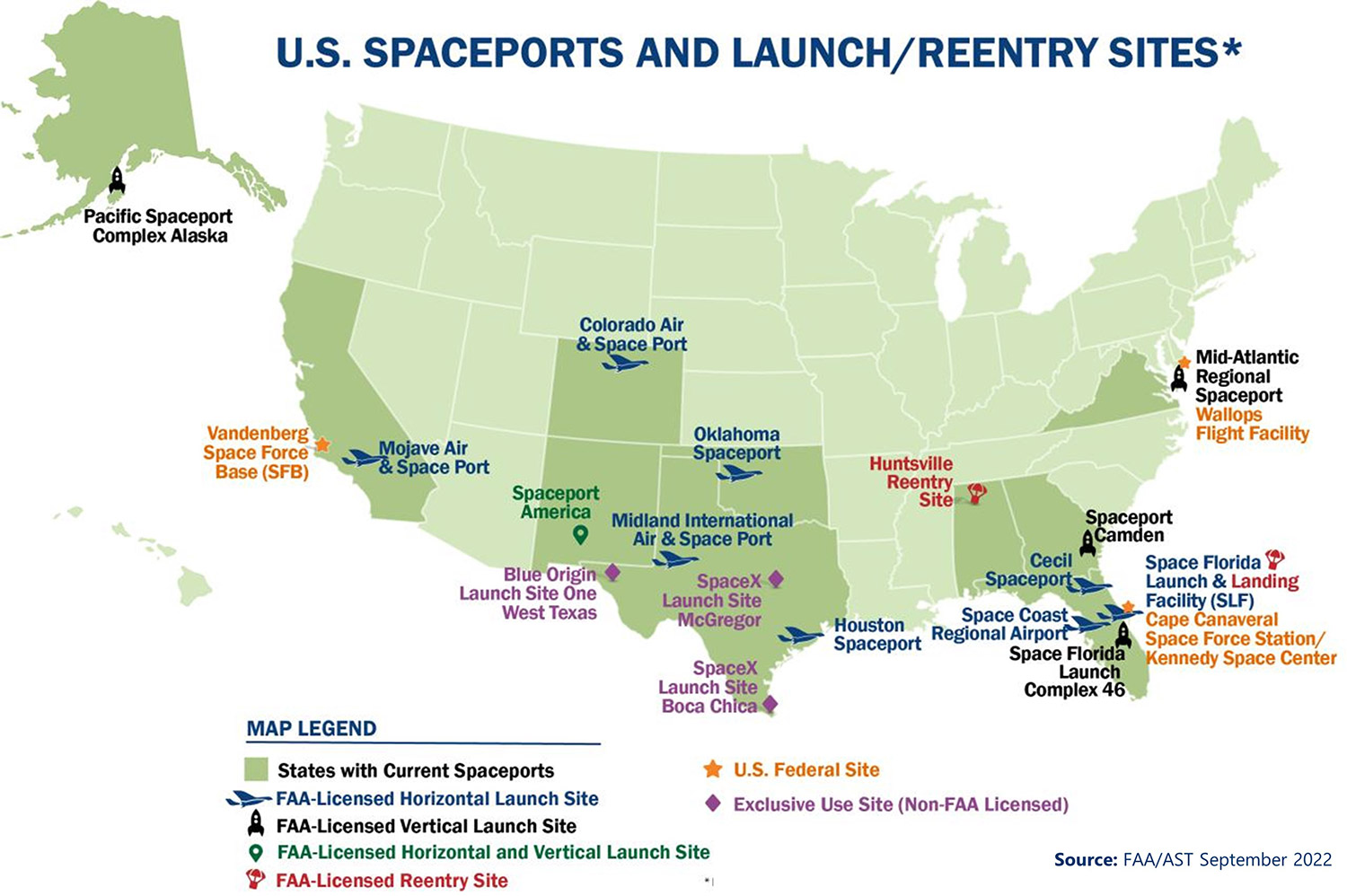
The Space Economy and American Communities
As the Space Economy continues to evolve, US communities have several avenues for engagement, positioning themselves as key players in this rapidly expanding sector.
Local governments can attract space-related companies and foster a skilled workforce by investing in STEM education, workforce development programs, and infrastructure.
Collaborating with universities and research institutions can help meet space-related research and development needs while creating pipelines for talent and innovation.
Establishing favorable regulatory environments and offering tax incentives may further stimulate investments in the Space Economy.
With collaborative efforts between government, academia, and industry, the US can maintain its leadership in the Space Economy while ensuring that the economic benefits of this evolving frontier are widely shared.
Camoin Associates is a national leader in industry analytics and strategy. We leverage cutting-edge economic data and tools to understand the ever-changing needs of an industry, evolving supply chains, and talent needs of the future.
Learn more about our Industry Analytics and STrategy services
📍 Related Article: Global Trends, Technology, and Workforce Creating Challenges and Opportunities in Aerospace and Defense




